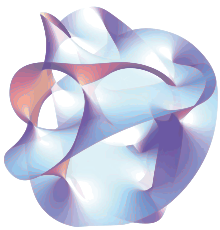Conjectura de SYZ – Wikipédia, a enciclopédia livre
| Série de artigos sobre |
| Teoria das cordas |
|---|
 |
| História |
A conjectura de SYZ é uma tentativa de entender a conjectura de simetria espelho, uma questão em física teórica e matemática. A conjectura original foi proposta em um artigo por Strominger, Yau e Zaslow, intitulado "Mirror Symmetry is T-duality".[1]
Juntamente com a conjectura de simetria espelho homológica,[2][3][4][5][6][7] é uma das ferramentas mais exploradas para entender a simetria espelho em termos matemáticos. Enquanto a simetria espelho homological é baseado em álgebra homológica, a conjectura SYZ é uma realização geométrica da simetria especular.[8][9]
Referências
- ↑ Strominger, Andrew; Yau, Shing-Tung; Zaslow, Eric (1996), «Mirror symmetry is T-duality», Nuclear Physics B, 479 (1–2): 243–259, Bibcode:1996NuPhB.479..243S, arXiv:hep-th/9606040
 , doi:10.1016/0550-3213(96)00434-8.
, doi:10.1016/0550-3213(96)00434-8. - ↑ Candelas, Philip; de la Ossa, Xenia C.; Green, Paul S.; Parkes, Linda (1991). «A pair of Calabi-Yau manifolds as an exactly soluble superconformal theory». Nuclear Physics B. 359 (1): 21–74. Bibcode:1991NuPhB.359...21C. MR 1115626. doi:10.1016/0550-3213(91)90292-6
- ↑ Kontsevich, Maxim (1994). «Homological algebra of mirror symmetry». arXiv:alg-geom/9411018

- ↑ Kontsevich, Maxim; Soibelman, Yan (2000). «Homological Mirror Symmetry and torus fibrations». arXiv:math.SG/0011041

- ↑ «Hodge diamond of complete intersections». math.stackexchange.com. Consultado em 6 de março de 2017
- ↑ «Cohomology tables for complete intersections». pbelmans.ncag.info. Consultado em 6 de março de 2017
- ↑ Nicolaescu, Liviu. «Hodge Numbers of Complete Intersections» (PDF)
- ↑ Becker, Katrin; Becker, Melanie; Strominger, Andrew (1995), «Fivebranes, membranes and non-perturbative string theory», Nuclear Physics B, 456 (1–2): 130–152, Bibcode:1995NuPhB.456..130B, arXiv:hep-th/9507158
 , doi:10.1016/0550-3213(95)00487-1.
, doi:10.1016/0550-3213(95)00487-1. - ↑ Harvey, Reese; Lawson, H. Blaine, Jr. (1982), «Calibrated geometries», Acta Mathematica, 148 (1): 47–157, doi:10.1007/BF02392726.


 French
French Deutsch
Deutsch